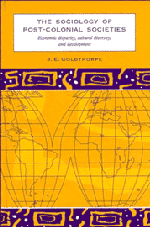Book contents
- Frontmatter
- Contents
- Preface and acknowledgements
- 1 Introduction and argument
- 2 Technology, society, and population
- 3 The colonial episode and the race question
- 4 Economic conditions
- 5 Environmental concerns
- 6 The social sciences and the ‘Third World’
- 7 The rise of towns
- 8 Family life in a changing world: two studies
- 9 Cultural diversity, language, education, and communications
- 10 Religion and development
- 11 Individual modernization: some psychological studies
- 12 Politics in post-colonial states
- 13 Aid and development
- Notes
- Index
2 - Technology, society, and population
Published online by Cambridge University Press: 03 May 2011
- Frontmatter
- Contents
- Preface and acknowledgements
- 1 Introduction and argument
- 2 Technology, society, and population
- 3 The colonial episode and the race question
- 4 Economic conditions
- 5 Environmental concerns
- 6 The social sciences and the ‘Third World’
- 7 The rise of towns
- 8 Family life in a changing world: two studies
- 9 Cultural diversity, language, education, and communications
- 10 Religion and development
- 11 Individual modernization: some psychological studies
- 12 Politics in post-colonial states
- 13 Aid and development
- Notes
- Index
Summary
The natural history of the human population of the earth from the emergence of Homo sapiens to the present day (fig. 1)
There have been two great technological revolutions in human history. Each was accompanied by a population explosion.
Ten or twelve thousand years ago, Homo sapiens was a relatively rare species found living in small bands by hunting and food-gathering. Some human groups do so to this day, or did so till recently, including the Australian aborigines; a few small groups in Africa, such as those popularly called ‘Bushmen’, and the Hadza of Tanzania; the Andaman islanders; and some Amazon forest peoples. From studies which have been done of the population density of people living in this way, it may be surmised that there can have been no more than 10 million humans on earth before the development of agriculture, and the actual population was perhaps 1 to 5 million.
Between about 9000 and 5500 BC, there occurred the first great technological revolution in human history. It involved a complex of inventions rather than one single crucial discovery. The domestication of a number of plant species, especially the grain seeds, greatly increased the carrying capacity of the land, or at least of land in some parts of the earth, and also made possible the storage of food, and both necessitated and permitted the growth of a settled population. This in turn stimulated the building of houses, an advance on the temporary shelters of food-gathering wanderers.
- Type
- Chapter
- Information
- The Sociology of Post-Colonial SocietiesEconomic Disparity, Cultural Diversity and Development, pp. 17 - 44Publisher: Cambridge University PressPrint publication year: 1996



